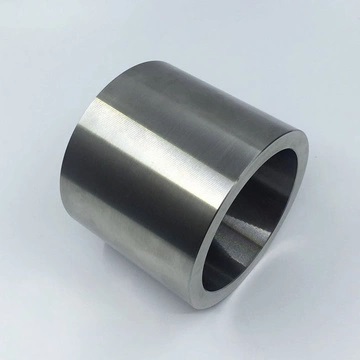The machinability of titanium alloy is: low density, poor thermal conductivity, and cutting heat is not easy to diffuse during cutting, resulting in a short tool life. Titanium alloy has high affinity; it has high chemical activity and is easy to interact with the metal in contact, resulting in increased adhesion, diffusion, and tool wear; titanium alloy has low elastic modulus and large elastic deformation, which will make the processed surface and the back knife The contact area of the surface is large, and the wear is serious.
Due to the small modulus of elasticity of titanium alloy, the clamping deformation and force deformation of the workpiece during processing will reduce the processing accuracy of the workpiece; the clamping force should not be too large when the workpiece is installed, and auxiliary support can be added when necessary.
If a cutting fluid containing hydrogen is used, it will decompose and release hydrogen at high temperatures during the cutting process, which will be absorbed by titanium and cause hydrogen embrittlement; it may also cause high-temperature stress corrosion cracking of titanium alloys.
The chloride in the cutting fluid may also decompose or volatilize toxic gases during use. Safety protection measures should be taken when using it, otherwise it should not be used; after cutting, the parts should be thoroughly cleaned with a chlorine-free cleaning agent in time to remove chlorine residues.

The use of tools and fixtures made of lead or zinc-based alloys is prohibited from contacting titanium alloys, and the use of copper, tin, cadmium and their alloys is also prohibited.
All the tools, fixtures or other devices in contact with the titanium alloy must be clean; the cleaned titanium alloy parts must be prevented from being contaminated by grease or fingerprints, otherwise it may cause salt (sodium chloride) stress corrosion in the future.
Under normal circumstances, there is no danger of ignition when cutting titanium alloys. Only in micro-cutting, the small chips cut off will ignite and burn. In order to avoid fire, in addition to pouring a large amount of cutting fluid, it is also necessary to prevent the accumulation of chips on the machine tool. The tool should be replaced immediately after being blunt, or the cutting speed should be reduced, and the feed rate should be increased to increase the thickness of the chip. In case of fire, fire extinguishing equipment such as talcum powder, limestone powder, dry sand should be used to extinguish the fire. Carbon tetrachloride and carbon dioxide fire extinguishers are strictly prohibited, and watering is prohibited, because water can accelerate combustion and even cause hydrogen explosion.



